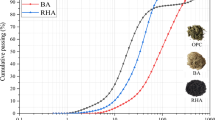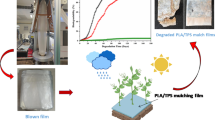Abstract
Coir pith is one of the most common agricultural wastes in the southern coastal regions of India, where the coconut is important to both the economy and way of life. The primary goals of this endeavour are the development and testing of nanocomposite materials from coir-pith agricultural waste for structural applications. Compression moulding was used to create the composites. The coir pith filler was pre-treated with a 5% NaOH solution for 4 h before manufacturing. The effects of nano silicon dioxide (NS) and nano clay (NC) at various concentrations on the morphological, physical, and mechanical characteristics of coir-based nanocomposite (1.5, 3, and 4.5 wt%) were also looked at. The mechanical characteristics increased the most at 4.5 wt% NS loading and 3 wt% NC loading. The swelling of the composite thickness and water absorption were both reduced by the addition of various nanoparticles. The integration of NS at 1, 3, and 4.5 wt% lowered water absorption after 20 days while also reducing water permeability by 5, 8, and 18.25%, respectively. Comparatively, inclusion at a high concentration (4.5 weight percent) increased moisture content by 3.96% as a result of NC filler agglomeration, but inclusion at 1.5 and 3 weight percent reduced water uptakes by 4.21% and 9.01%, respectively. Scanning electron microscopy (SEM) was used to demonstrate the interactions of the coir pith with polymer matrixes and the effect of NS and NC on adhesion enhancement. Fourier transform infrared spectroscopy (FTIR) was used to determine how well the coir pith, NaOH pre-treatment, and nanofillers adhered to one another.
Similar content being viewed by others
Data Availability
The data used to support the findings of this study are included in the article. Should further data or information be required, these are available from the corresponding author upon request.
References
Sahmetlioglu E, Mart H, Yuruk H, Surme Y (2006) Synthesis and characterization of oligosalicylaldehyde-based epoxy resins. Chem Pap 60:65–68. https://doi.org/10.2478/s11696-006-0012-1
Haq M, Burgueño R, Mohanty AK, Misra M (2008) Hybrid bio-based composites from blends of unsaturated polyester and soybean oil reinforced with nanoclay and natural fibers. Compos Sci Technol 68:3344–3351. https://doi.org/10.1016/j.compscitech.2008.09.007
Rajasekar R, Pal K, Heinrich G et al (2009) Development of nitrile butadiene rubber-nanoclay composites with epoxidized natural rubber as compatibilizer. Mater Des 30:3839–3845. https://doi.org/10.1016/j.matdes.2009.03.014
Yang Z, Peng H, Wang W, Liu T (2010) Crystallization behavior of poly(ε-caprolactone)/layered double hydroxide nanocomposites. J Appl Polym Sci 116:2658–2667. https://doi.org/10.1002/app
Hosseini SB (2017) A review: nanomaterials as a filler in natural fiber reinforced composites. Journal of Natural Fibers 14:311–325. https://doi.org/10.1080/15440478.2016.1212765
Asasutjarit C, Charoenvai S, Hirunlabh J, Khedari J (2009) Materials and mechanical properties of pretreated coir-based green composites. Compos B Eng 40:633–637. https://doi.org/10.1016/j.compositesb.2009.04.009
Brasileiro GAM, Vieira JAR, Barreto LS (2013) Use of coir pith particles in composites with Portland cement. J Environ Manage 131:228–238. https://doi.org/10.1016/j.jenvman.2013.09.046
Narendar R, Priya Dasan K (2014) Chemical treatments of coir pith: morphology, chemical composition, thermal and water retention behavior. Compos B Eng 56:770–779. https://doi.org/10.1016/j.compositesb.2013.09.028
Narendar R, Priya Dasan K, Nair M (2014) Development of coir pith/nylon fabric/epoxy hybrid composites: mechanical and ageing studies. Mater Des 54:644–651. https://doi.org/10.1016/j.matdes.2013.08.080
Ganesan V, Kaliyamoorthy B (2020) Utilization of Taguchi technique to enhance the interlaminar shear strength of wood dust filled woven jute fiber reinforced polyester composites in cryogenic environment. J Nat Fibers. https://doi.org/10.1080/15440478.2020.1789021
Jose AS, Athijayamani A, Ramanathan K, Sidhardhan S (2017) Effects of an addition of coir-pith particles on the mechanical properties and erosive-wear behavior of a wood-dust-particle-reinforced phenol formaldehyde composite. Mater Tehnol 51:805–811. https://doi.org/10.17222/mit.2016.284
Chen H, Zhang W, Wang X et al (2018) Effect of alkali treatment on wettability and thermal stability of individual bamboo fibers. J Wood Sci 64:398–405. https://doi.org/10.1007/s10086-018-1713-0
Li X, Tabil LG, Panigrahi S (2007) Chemical treatments of natural fiber for use in natural fiber-reinforced composites: a review. J Polym Environ 15:25–33. https://doi.org/10.1007/s10924-006-0042-3
Zakikhani P, Zahari R, Sultan MTH, Majid DL (2014) Extraction and preparation of bamboo fibre-reinforced composites. Mater Des 63:820–828. https://doi.org/10.1016/j.matdes.2014.06.058
Velmurugan G, Babu K (2020) Statistical of mechanical properties of wood dust filled jute fiber based hybrid composites under cryogenic atmosphere using Grey- Taguchi method mater. Res Express 7:065310. https://doi.org/10.1088/2053-1591/ab9ce9
Bakhori SNM, Hazzan MZ, Bakhori NM et al (2022) Mechanical properties od PALF/Kevlar-Reinforced unsaturated polyester hybrid composite laminates. Polymers 14: 2468. https://doi.org/10.3390/polym14122468
Kavya HM, Bavan S, Yogesha B et al (2021) Effect of coir fiber and inorganic filler on physical and mechanical properties of epoxy based hybrid composites. Polym Compos 42:3911–3921. https://doi.org/10.1002/pc.26103
Awad SA, Khalaf EM (2019) Investigation of improvement of properties of polypropylene modified by nano silica composites. Composites Communications 12:59–63. https://doi.org/10.1016/j.coco.2018.12.008
Rajaei M, Kim NK, Bickerton S, Bhattacharyya D (2019) A comparative study on effects of natural and synthesised nano-clays on the fire and mechanical properties of epoxy composites. Compos B Eng 165:65–74. https://doi.org/10.1016/j.compositesb.2018.11.089
Rajeshkumar G, Seshadri SA, Ramakrishnan S et al (2021) A comprehensive review on natural fiber/nano-clay reinforced hybrid polymeric composites: materials and technologies. Polym Compos 42:3687–3701. https://doi.org/10.1002/pc.26110
Sadik WAA, El Demerdash AGM, Abbas R, Bedir A (2021) Effect of nanosilica and nanoclay on the mechanical, physical, and morphological properties of recycled linear low density polyethylene/rice husk composites. J Polym Environ 29:1600–1615. https://doi.org/10.1007/s10924-020-01983-6
Razavi SM, Nazarpour H, HosseinaliBeygi M (2021) Investigation of the efficacy of nano-silica on mechanical properties of Green-Engineered Cementitious Composite (GECC) containing high volume natural zeolite. Constr Build Mater 291:123246. https://doi.org/10.1016/j.conbuildmat.2021.123246
Yoon YS, Jee SH, Lee SH, Nam SC (2011) Nano Si-coated graphite composite anode synthesized by semi-mass production ball milling for lithium secondary batteries. Surf Coat Technol 206:553–558. https://doi.org/10.1016/j.surfcoat.2011.07.076
Tang C, Li X, Yin F, Hao J (2017) The performance improvement of aramid insulation paper by nano-SiO2 modification. IEEE Trans Dielectr Electr Insul 24:2400–2409. https://doi.org/10.1109/TDEI.2017.006560
Chun KS, Husseinsyah S (2016) Agrowaste-based composites from cocoa pod husk and polypropylene: effect of filler content and chemical treatment. J Thermoplast Compos Mater 29:1332–1351. https://doi.org/10.1177/0892705714563125
Tsai JL, Cheng YL (2009) Investigating silica nanoparticle effect on dynamic and quasi-static compressive strengths of glass fiber/epoxy nanocomposites. J Compos Mater 43:3143–3155. https://doi.org/10.1177/0021998309345317
Ramesh M, Palanikumar K, Hemachandra Reddy K (2016) Evaluation of mechanical and interfacial properties of sisal/jute/glass hybrid fiber reinforced polymer composites. Trans Indian Inst Met 69:1851–1859. https://doi.org/10.1007/s12666-016-0844-5
Sekar S, Suresh Kumar S, Vigneshwaran S, Velmurugan G (2020) Evaluation of mechanical and water absorption behavior of natural fiber-reinforced hybrid biocomposites. J Nat Fibers 00:1–11. https://doi.org/10.1080/15440478.2020.1788487
Ng LF, Yahya MY, Muthukumar C (2022) Mechanical characterization and water absorption behaviors of pineapple leaf/glass fiber-reinforced polypropylene hybrid composites. Polym Compos 43:203–214. https://doi.org/10.1002/pc.26367
Badaruzzaman WHW, Dabbagh NMR, Salleh KM et al (2022) Mechanical properties and water absorption capacity of hybrid GFRP composites. Polymers 14:1–10. https://doi.org/10.3390/polym14071394
Ramesh M, Logesh R, Manikandan M et al (2017) Mechanical and water intake properties of banana-carbon hybrid fiber reinforced polymer composites. Mater Res 20:365–376. https://doi.org/10.1590/1980-5373-MR-2016-0760
Forintos N, Czigany T (2019) Multifunctional application of carbon fiber reinforced polymer composites: electrical properties of the reinforcing carbon fibers – a short review. Compos B Eng 162:331–343. https://doi.org/10.1016/j.compositesb.2018.10.098
Mendonça MGS, de Almeida TS, Daniel CRA, Barreto LS (2020) Carbon fiber effect on the physico-mechanical and durability properties of a cement/coir pith composite. Sustain Mater Technol 25:e00187. https://doi.org/10.1016/j.susmat.2020.e00187
Lakshmaiya N, Kaliappan S, Patil PP et al (2022) Influence of oil palm nano filler on interlaminar shear and dynamic mechanical properties of flax/epoxy-based hybrid nanocomposites under cryogenic condition. Coatings 12:1675. https://doi.org/10.3390/coatings12111675
Natrayan L, Kumar PVA, Baskara Sethupathy S et al (2022) Effect of nano TiO2Filler addition on mechanical properties of bamboo/polyester hybrid composites and parameters optimized using grey Taguchi method. Adsorp Sci Technol 2022:6768900. https://doi.org/10.1155/2022/6768900
Ponnusamy M, Natrayan L, Patil PP et al (2022) Statistical analysis on interlaminar shear strength of nanosilica addition with woven dharbai/epoxy hybrid nanocomposites under cryogenic environment by Taguchi technique. Adsorp Sci Technol 2022:6571515. https://doi.org/10.1155/2022/6571515
Senthilkumar K, Chandrasekar M, Alothman OY et al (2022) Flexural, impact and dynamic mechanical analysis of hybrid composites: olive tree leaves powder/ pineapple leaf fibre/epoxy matrix. J Market Res 21:4241–4252. https://doi.org/10.1016/j.jmrt.2022.11.036
Liu L, Jia C, He J et al (2015) Interfacial characterization, control and modification of carbon fiber reinforced polymer composites. Compos Sci Technol 121:56–72. https://doi.org/10.1016/j.compscitech.2015.08.002
Karimzadeh A, Yahya MY, Abdullah MN, Wong KJ (2020) Effect of stacking sequence on mechanical properties and moisture absorption characteristic of hybrid PALF/glass fiber composites. Fibers Polym 21:1583–1593. https://doi.org/10.1007/s12221-020-9640-2
Chauhan A, Kumari S, Verma R et al (2022) Fabrication of copper oxide nanoparticles via microwave and green approaches and their antimicrobial potential. Chem Pap 76:7147–7162. https://doi.org/10.1007/s11696-022-02407-6
Chowdary MS, Raghavendra G, Kumar MSRN et al (2022) Influence of nano-silica on enhancing the mechanical properties of sisal/kevlar fiber reinforced polyester hybrid composites. Silicon 14:539–546. https://doi.org/10.1007/s12633-020-00846-y
Singh T, Gangil B, Ranakoti L, Joshi A (2021) Effect of silica nanoparticles on physical, mechanical, and wear properties of natural fiber reinforced polymer composites. Polym Compos 42:2396–2407. https://doi.org/10.1002/pc.25986
Pansambal S, Oza R, Borgave S et al (2022) Bioengineered cerium oxide ( CeO 2) nanoparticles and their diverse applications : a review. Appl Nanosci. https://doi.org/10.1007/s13204-022-02574-8
Munikenche Gowda T, Naidu ACB, Chhaya R (1999) Some mechanical properties of untreated jute fabric-reinforced polyester composites. Compos A Appl Sci Manuf 30:277–284. https://doi.org/10.1016/S1359-835X(98)00157-2
Gujjala R, Ojha S, Acharya SK, Pal SK (2014) Mechanical properties of woven jute-glass hybrid-reinforced epoxy composite. J Compos Mater 48:3445–3455. https://doi.org/10.1177/0021998313501924
Ashok Kumar M, Ramachandra Reddy G, Siva Bharathi Y et al (2010) Frictional coefficient, hardness, impact strength, and chemical resistance of reinforced sisal-glass fiber epoxy hybrid composites. J Compos Mater 44:3195–3202. https://doi.org/10.1177/0021998310371551
Acknowledgements
The authors thank Muthayammal Engineering College, Namakkal, Tamil Nadu, India for the technical assistance
Author information
Authors and Affiliations
Contributions
Matheswaran M: Conceptualization, Writing an original draft, Methodology;
Suresh P: Investigation, Review.
Velmurugan G: Testing and Evaluation.
Nagaraj M: Editing.
Corresponding author
Ethics declarations
Ethics Approval
Not applicable.
Consent for Publication
Yes. All permission granted.
Consent to Participate
Not applicable.
Competing Interests
The authors declare no competing interests.
Additional information
Publisher's Note
Springer Nature remains neutral with regard to jurisdictional claims in published maps and institutional affiliations.
Rights and permissions
Springer Nature or its licensor (e.g. a society or other partner) holds exclusive rights to this article under a publishing agreement with the author(s) or other rightsholder(s); author self-archiving of the accepted manuscript version of this article is solely governed by the terms of such publishing agreement and applicable law.
About this article
Cite this article
M., M., P., S., G., V. et al. Evaluation of Agrowaste/Nanoclay/SiO2-Based Blended Nanocomposites for Structural Applications: Comparative Physical and Mechanical Properties. Silicon 15, 7095–7108 (2023). https://doi.org/10.1007/s12633-023-02570-9
Received:
Accepted:
Published:
Issue Date:
DOI: https://doi.org/10.1007/s12633-023-02570-9




